Warning: Exhaust system components should not be inspected or repaired until sufficient time has elapsed after driving for the system components to cool completely. This is especially true for the catalytic converter, which operates at very high temperatures. Before working under the vehicle, make sure it is securely supported.
General information
1. On models with 4-cylinder engines manufactured before 01.1998, the exhaust system consists of an exhaust manifold. exhaust pipe and catalytic converter, as well as the rear section, which contains two (or three for some models) muffler and exhaust pipe assembly. The replacement exhaust system consists of three or four sections: front pipe/catalytic converter, intermediate pipe and front silencer, and exhaust pipe and rear silencer. As an option, the exhaust pipe can consist of two parts with two mufflers. The entire exhaust system is suspended from the body on rubber mounts.
2. On models with 4-cylinder engines from 01.1998, the exhaust system consists of an exhaust manifold, a downpipe and a catalytic converter, as well as a rear section that contains two mufflers and an exhaust pipe assembly (see fig.15.2).
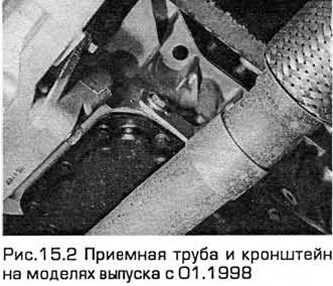
3. On V-6 models, the exhaust system includes two fork-section exhaust manifolds, a catalytic converter, and a rear section with three mufflers (see Fig.15.3, a-c).
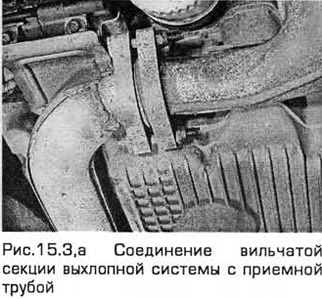
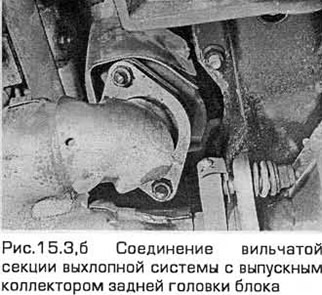
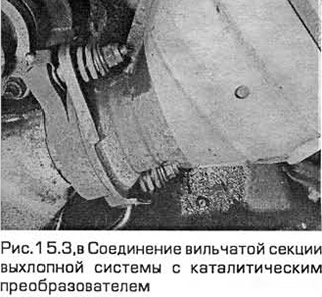
4. On all midships, the exhaust system is installed in rubber supports located along its entire length (see fig. 15.4).
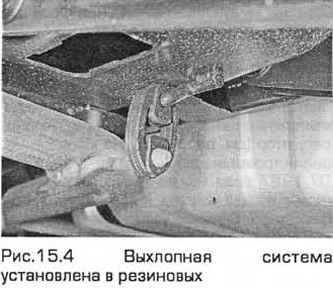
Component Replacement
5. If any of the above components is damaged or destroyed, then this is manifested by excessive noise and vibration.
6. Inspect the exhaust system regularly to keep the noise level low and the system reliable. Look for damaged or bent parts, cracked welds, holes, loose joints and joints, excessive corrosion, and other defects that could allow exhaust fumes to enter the vehicle. Failed components of the system cannot be repaired, they must be replaced with new ones.
7. If the components of the exhaust system have undergone significant corrosion or rusted to each other, then they should be cut off from the exhaust system. And you need to entrust it to specialists. If you want to do it yourself, then cut off the defective components with a hacksaw (if you do not have gas cutting equipment). You can also use a pneumatic tool with a cutting attachment for this job. At the same time, protect your eyes from metal chips and work with gloves. To repair a system installed during the manufacture of a car, it must be cut off at the indicated points (see fig.15.7,a,b) in order to install sections from the exhaust system repair kit.

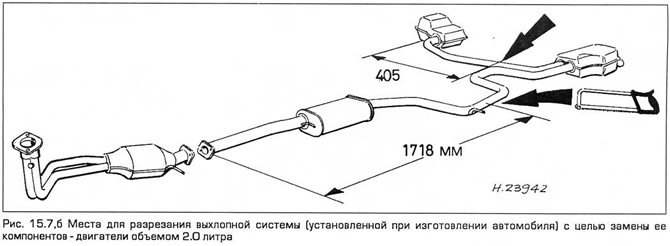
8. When repairing the exhaust system, follow simple rules:
Warning: The catalytic converter gets very hot and takes a long time to cool down. Allow it to cool completely before removing it. Failure to follow these instructions could result in serious burns.
- A) Remove the components of the exhaust system, starting from the rear end and gradually approach the beginning of the exhaust system.
- b) Use kerosene or another liquid that penetrates well into the joints as an aid in removing components and separating its fasteners.
- V) When installing the exhaust system components, install new gaskets, rubber supports and clamps.
- G) Apply an anti-seize compound to all threads of the exhaust system fasteners when reassembling.
- d) Note that on some models the downpipe is secured to the manifold with two bolts, each with a coil spring, a spring seat and a self-locking nut. When installing, tighten the nuts until they rest against the bolt shoulder. This creates a spring tension sufficient to ensure a tight joint (see fig. 15.8). Do not overtighten the nuts to try to stop a leak or the bolts will shear off. Replace gasket and spring if leaks are found
- e) Make sure there is sufficient clearance between the newly installed components and the bodywork. This prevents overheating of the floor panel and possible damage to the mat and insulation material. Pay special attention to the catalytic converter and its heat-insulating casing.
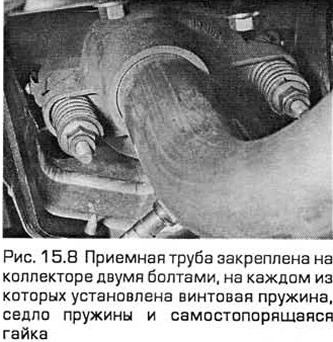
Visitor comments